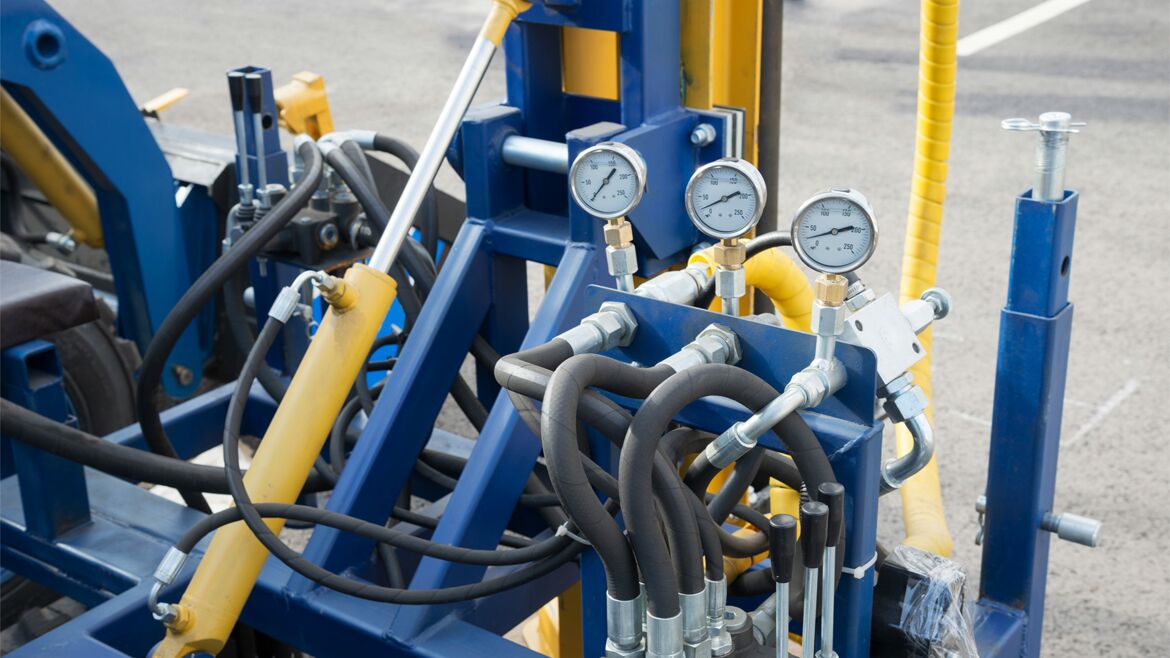O-rings in the industry


The 11 most important materials for (almost) every application
O-rings are true all-rounders in industry and everyday life - they can be used in almost every conceivable industry and, depending on the material, meet a wide variety of requirements.
This article provides you with a helpful overview of the 11 most important materials from which O-rings are typically made, as well as their respective properties and possible applications.
What is an O-ring?
O-rings are ring-shaped seals. The term O-ring comes from the round, O-shaped cross-section of the ring; alternatively, the terms round ring or zero ring are also used. In Germany, O-rings are standardized according to DIN ISO 3601 and the size is specified as inner diameter x cord diameter. O-rings are manufactured in various standard sizes, but special dimensions are also possible.
O-rings are the most commonly used seals - they are very reliable and easy to install, making them particularly popular for industrial applications. The sealing rings are usually made of elastomers (rubber), but O-rings made of plastics or metals are also possible. In this article, we mainly refer to the various materials made of rubber.
How are O-rings used?
O-rings are used in many areas of industry. As the primary sealing element in a groove, the O-ring prevents the unwanted leakage of liquids or gases. Compression gives the O-ring its sealing effect between the two parts and its flexibility allows it to adapt well to tolerances.
The O-ring is most frequently used in static applications, where it has proven to be foolproof: If the sealing points are designed correctly, an installation error is unlikely, but the O-ring also seals reliably in the event of minor errors.
O-rings are also used in dynamic applications, for example as piston or rod seals in hydraulic cylinders. They are most effective in this area with short strokes and small diameters.
The advantages of the O-ring
If you compare the O-ring with other sealing elements, it has the following advantages:
- Wide range of applications
- Simple calculation of the groove
- Self-sealing and pressure-supported sealing
- Large selection of materials
- Easy handling and assembly
- No need for retensioning or retightening
- Economically viable
11 Materials for O-rings and their properties
O-rings can be made from many different materials, on which the properties of the respective O-ring depend. Below we list the best-known materials for O-rings as well as their properties and typical areas of application:
Acrylonitrile butadiene rubber (NBR)
Acrylonitrile butadiene rubber is also known under the brand name Perbunan N (formerly Buna N). As NBR has very good resistance to vegetable and animal oils and fats as well as good mechanical properties, the typical area of application for these O-rings is hydraulics.
NBR O-rings can be used in a temperature range from approx. -20 to +100 °C and up to 120 °C for short periods. However, use at high temperatures accelerates the ageing of the ring.
Chloroprene rubber (CR) or neoprene (NE)
Chloroprene rubber is better known as neoprene in German-speaking countries and was one of the first synthetic rubbers to be developed. O-rings made from this material have good resistance to ozone, weather, chemicals and ageing, as well as good flame resistance. As the rings also have good resistance to refrigerants, they are also frequently used in air conditioning units. The hardness of the O-ring increases at high temperatures in atmospheric oxygen.
They can be used in a temperature range of approx. -40 to +100 °C and up to 120 °C for short periods.
Ethylene-propylene rubber (EPM, EPDM)
O-rings made of EPDM are resistant to hot water and steam, brake fluids, detergents and silicone oils and greases. Caution is advised with mineral oils and animal fats such as milk. O-rings made of this material are considered safe in connection with foodstuffs in conjunction with a corresponding approval, such as FDA conformity, and are therefore frequently found in the food industry.
The resistance lies in a temperature range between approx. -50 to +150 °C and can be up to approx. +180 °C for special grades.
Fluorocarbon rubber (FKM)
FKM is often referred to as Viton®, which is the trade name for “DuPont Performance Elastomers”. It is one of the most important material developments, as the material has a wide range of applications and is also suitable for food applications in conjunction with a corresponding approval. FKM O-rings are used, for example, as seals for detachable flange connections in vacuum technology.
FKM has many advantages:
- Good resistance to propane, butane and natural gas
- Fuel resistance
- Resistant to mineral and silicone oils and greases
- Resistant to aromatic hydrocarbons
- Low gas permeability
- Good chemical resistance
- Heat resistance
O-rings made of FKM can be used in a temperature range from approx. -20 to +200 °C.
Fluorosilicone rubber (FVMQ)
In addition to the typical properties of normal silicone rubber, fluorosilicone rubber also has improved resistance to oils, fuels and solvents and in particular to aromatic and chlorinated hydrocarbons and alcohols. Another property is its very good resistance to low temperatures. O-rings made from this material are mostly used in static environments and are often used in aerospace applications.
The optimum temperature range for using FVMQ O-rings is approx. -55 to +175 °C.
Hydrogenated nitrile butadiene rubber (HNBR)
Hydrogenation bonds hydrogen atoms to the double bond of the butadiene molecules. This gives O-rings made of HNBR the advantage of increased thermal resistance. In addition to being resistant to ozone and weathering, they are also resistant to vegetable and animal fats and oils. O-rings made of HNBR can also withstand solutions and emulsions with the designation HFA, HFB and HFC.
These O-rings can be used in a temperature range from approx. -20 to +150 °C.
Perfluoro rubber (FFKM)
FFKM is considered a high-temperature material and has particularly good resistance to almost all chemicals. For this reason, it is often used where other O-rings fail or would only have a short service life. FFKM O-rings are most frequently used in chemical plants, oil production or in high-pressure and fitting applications.
FFKM O-rings can be used in a temperature range from approx. -15 to +310 °C.
Polyurethane rubber (AU, EU)
O-rings made of polyurethane rubber are characterized in particular by their high wear resistance in combination with mineral and silicone oils as well as ozone exposure. They offer high performance in terms of tear and abrasion resistance as well as elasticity.
The EU material is more resistant to hydrolysis than the AU material and is therefore ideally suited for use with aqueous media.
The temperature range of the polyurethane materials extends from approx. -40 to +90 °C.
Polytetrafluoroethylene (PTFE)
O-rings made of polytetrafluoroethylene (colloquially known as Teflon) have universal resistance to alcohols, bases, petrols, ketones and aggressive acids and offer very good sliding properties. Another advantage is that PTFE O-rings exhibit low wear and therefore have a long service life.
PTFE O-rings can be used in a wide temperature range from -200 to +260 °C.
Silicone rubbers (LSR, Q, MQ, VMQ)
O-rings made of silicone have a very high heat resistance with simultaneous low-temperature flexibility and are also characterized by their excellent ageing resistance. With the appropriate approvals, silicone O-rings are FDA-compliant and biocompatible and can be used in the food, medical and pharmaceutical industries.
Silicone O-rings have good resistance to water (up to 100 °C), motor and gear oil, animal and vegetable oils and fats as well as diluted salt solutions. They are also resistant to ozone, ageing and weathering.
They can be used in a temperature range from approx. -55 to +210 °C without any problems.
Styrene butadiene rubber (SBR)
SBR was originally developed in Germany as Buna S. As SBR O-rings have good resistance to water, alcohols and glycols, they are mostly used for glycol-based brake fluids and in automotive hydraulics.
These O-rings are also resistant to silicone oils and greases as well as diluted, aqueous solutions of weak acids, bases and salts. However, caution is advised with mineral oils and greases as well as fuels, as SBR O-rings cannot withstand these substances.
The temperature range for using the O-rings is between approx. -50 and +100 °C.
O-rings in the industry context
The diverse use of O-rings in industry is almost sector-independent. To give you an overview, we list below the largest and best-known sectors in which O-rings are used. However, fluid technology, the petroleum industry and refrigeration and air conditioning technology are also worth mentioning.
Automotive industry
The requirements for O-rings in this industry are extremely application-specific: they must offer high performance and good chemical resistance. There are many areas in the automotive industry where O-rings are used and provide the connection to the end user:
Engine
Brake system
Fuel system
Transmission
Air conditioning
Emission reduction
Food, medical and pharmaceutical industries
O-rings for the food and pharmaceutical industries must comply with various standards and guidelines. As these industries are particularly sensitive, the safety of food and people must be absolutely guaranteed. For this reason, high demands are placed on the O-rings used.
The biocompatibility of the O-rings used has top priority. This means that no toxic substances may be released and no reactions may occur in conjunction with other substances. The material must be resistant to acidic ingredients, fats and oils as well as various chemicals.
It is also important that the O-rings are not susceptible to mould or bacterial cultures and can withstand sterilization and disinfection processes without any problems. O-rings in the food, medical and pharmaceutical industries are subject to the highest demands and should still have the longest possible service life.
In these industries alone, the use of O-rings is extremely versatile. In the food sector, applications range from filling systems to coffee machines.
Aerospace
O-rings are also subject to particularly high requirements in the aerospace industry. Not only must they be highly resistant to chemical substances, they must also withstand a wide range of temperature and pressure conditions. This is the only way to prevent accidents and ensure safety. In some cases, the requirements are so high that special material developments and approvals are necessary.
O-rings are used in a wide range of applications in the aerospace industry:
Flight control systems
Engines
Brake systems
Flaps and valves
Pressure accumulators
Fuel systems
Conclusion: O-rings – versatile all-rounders
O-rings are probably the most versatile seals - from the size to the sometimes specially developed material, they have different properties and resistances that are of great importance for the respective application.
O-rings are particularly reliable in static applications. The advantages of O-rings are that they are self-sealing and pressure-supported, easy to handle and also inexpensive to purchase.
Their industry-independent use is suitable even for the highest demands. With a coordinated choice of materials and compliance with various standards and directives, they are also popular in critical sectors such as aerospace technology, the food sector and the medical and pharmaceutical industries. O-rings are absolute all-rounders, as they can be used in almost any industry thanks to the wide range of materials.


Book your individual consultation appointment now!
Talk to our experts to find out everything you need to know about our products and services. Book your online appointment now and work with us to find the right solution for your application!



